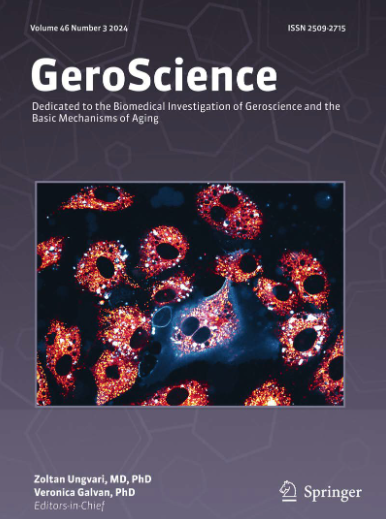Surface-based morphometry reveals divergent aging trajectories in veterans with and without traumatic brain injury.
IF 5.4
2区 医学
Q1 GERIATRICS & GERONTOLOGY
引用次数: 0
Abstract
This study investigates how traumatic brain injury (TBI) alters cortical aging by comparing cortical thickness (CT) and surface area (SA) in 34 brain regions between TBI survivors and age-matched controls. Using a cross-sectional retrospective design, 105 Vietnam Veterans (32 with moderate-to-severe TBI, 73 controls) were analyzed via surface-based morphometry. Principal Component Analysis (PCA) reduced dimensionality, and Multivariate Analysis of Covariance tested group differences while controlling for age, education, depression, Post-Traumatic Stress Disorder, and intracranial volume. Findings revealed divergent morphometric signatures of aging: the proportion of SA variance explained by the first principal component (PC1) was lower in the TBI cohort compared to controls, particularly in parietal and limbic regions. Conversely, CT variance explained by PC1 was higher in TBI compared to controls, with fewer factor loadings in frontal and occipital regions, suggesting differential structural aging patterns due to TBI. Regression analysis demonstrated a stronger association of SA with age in TBI (R2 = 0.619, p = 0.01), while CT exhibited significant negative age-related thinning in TBI-specific regions (R2 = 0.450, p < 0.001). Together, these results suggest that TBI survivors exhibit structured, yet distinct, cortical remodeling, contrasting with the more diffuse patterns seen in normal aging. The differentiated organization of brain areas based on CT and SA points to brain morphology-based biomarkers capable of distinguishing pathological from normative aging trajectories. These biomarkers hold translational potential for refining diagnostic models of brain age and informing targeted neuromodulation or rehabilitation strategies to support cognitive and functional resilience in older adults with TBI.基于表面的形态测量揭示了创伤性脑损伤退伍军人和非创伤性脑损伤退伍军人不同的衰老轨迹。
本研究通过比较创伤性脑损伤(TBI)幸存者和年龄匹配的对照组之间34个脑区域的皮质厚度(CT)和表面积(SA)来研究创伤性脑损伤(TBI)如何改变皮层老化。采用横断面回顾性设计,105名越南退伍军人(32名中度至重度TBI患者,73名对照组)通过基于表面的形态测量学进行了分析。主成分分析(PCA)降维和多变量协方差分析在控制年龄、教育程度、抑郁、创伤后应激障碍和颅内容积的情况下检验了组间差异。研究结果揭示了衰老的不同形态特征:与对照组相比,TBI队列中由第一主成分(PC1)解释的SA方差比例较低,特别是在顶叶和边缘区域。相反,与对照组相比,脑外伤患者PC1解释的CT方差更高,额叶和枕叶区域的因子负荷更少,表明脑外伤导致的不同结构老化模式。回归分析显示,SA与TBI患者的年龄有较强的相关性(R2 = 0.619, p = 0.01),而CT显示TBI特异性区域的年龄相关变薄呈显著负相关(R2 = 0.450, p < 0.001)。综上所述,这些结果表明,与正常衰老中更为分散的模式相比,创伤性脑损伤幸存者表现出结构化但明显的皮层重塑。基于CT和SA的脑区域分化组织指向基于脑形态学的生物标志物,能够区分病理和规范的衰老轨迹。这些生物标记物具有转化潜力,可用于完善脑年龄诊断模型,并告知有针对性的神经调节或康复策略,以支持老年TBI患者的认知和功能恢复能力。
本文章由计算机程序翻译,如有差异,请以英文原文为准。
求助全文
约1分钟内获得全文
求助全文
来源期刊

GeroScience
Medicine-Complementary and Alternative Medicine
CiteScore
10.50
自引率
5.40%
发文量
182
期刊介绍:
GeroScience is a bi-monthly, international, peer-reviewed journal that publishes articles related to research in the biology of aging and research on biomedical applications that impact aging. The scope of articles to be considered include evolutionary biology, biophysics, genetics, genomics, proteomics, molecular biology, cell biology, biochemistry, endocrinology, immunology, physiology, pharmacology, neuroscience, and psychology.
 求助内容:
求助内容: 应助结果提醒方式:
应助结果提醒方式:


